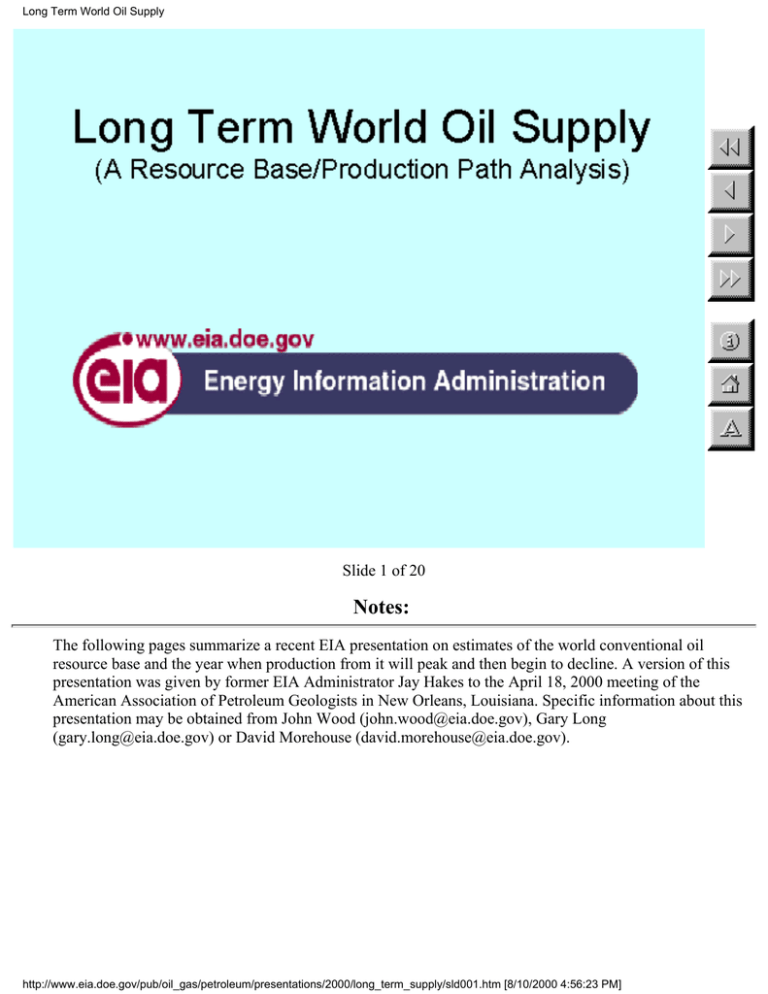Long Term World Oil Supply
advertisement

Long Term World Oil Supply Slide 1 of 20 Notes: The following pages summarize a recent EIA presentation on estimates of the world conventional oil resource base and the year when production from it will peak and then begin to decline. A version of this presentation was given by former EIA Administrator Jay Hakes to the April 18, 2000 meeting of the American Association of Petroleum Geologists in New Orleans, Louisiana. Specific information about this presentation may be obtained from John Wood (john.wood@eia.doe.gov), Gary Long (gary.long@eia.doe.gov) or David Morehouse (david.morehouse@eia.doe.gov). http://www.eia.doe.gov/pub/oil_gas/petroleum/presentations/2000/long_term_supply/sld001.htm [8/10/2000 4:56:23 PM] Slide 2 of 20 http://www.eia.doe.gov/pub/oil_gas/petroleum/presentations/2000/long_term_supply/sld002.htm [8/10/2000 4:56:24 PM] PPT Slide Slide 3 of 20 http://www.eia.doe.gov/pub/oil_gas/petroleum/presentations/2000/long_term_supply/sld003.htm [8/10/2000 4:56:25 PM] PPT Slide Slide 20 of 20 Notes: 1. This table summarizes EIA results based on the 3 USGS ultimate recovery volumes, 4 annual production growth rates, and a production decline after the peak at a constant reserves to production ratio of 10. 2. EIA estimates that, based on recent USGS estimates of the global oil resource base, worldwide oil production is likely to continue increasing for more than three decades. 3. EIA’s estimated production peaks are generally later in time than those estimated by other analysts. 4. EIA’s relative optimism is based on: (1) use of the current USGS world conventional oil resource estimates, which are both larger and more technically sound than past resource estimates used by others, and (2) use of a methodology for estimating the post-peak production path that is based on the reserve to production (R/P) ratio observed in the United States since oil production peaked in 1970. http://www.eia.doe.gov/pub/oil_gas/petroleum/presentations/2000/long_term_supply/sld020.htm [8/10/2000 4:56:26 PM] Long Term World Oil Supply (A Resource Base/Production Path Analysis) Long Term World Oil Supply (A Resource Base/Production Path Analysis) 07/28/2000 Click here to start Table of Contents Long Term World Oil Supply (A Resource Base/Production Path Analysis) Authors: John Wood, Gary Long Email: john.wood@eia.doe.gov Email: gary.long@eia.doe.gov Executive Summary Home Page: www.eia.doe.gov Executive Summary (Continued) Download presentation source Executive Summary (Continued) Overview The Year of Peak Production..When will worldwide conventional oil production peak?... Lower 48 Crude Oil Reserves & Production 1945-2000 Texas Oil and Condensate Production, and Texas First Purchase Price (FPP), 1980-1999 Published Estimates of World Oil Ultimate Recovery Different Interpretations of a Hypothetical 6,000 Billion Barrel World Original Oil-in-Place Resource Base Campbell-Laherrère World Oil Production http://www.eia.doe.gov/pub/oil_gas/petroleum/presentations/2000/long_term_supply/index.htm (1 of 2) [8/10/2000 4:56:26 PM] Long Term World Oil Supply (A Resource Base/Production Path Analysis) Estimates, 1930-2050 Laherrere’s Oil Production Forecast, 1930-2150 EIA World Oil Production Projections, 1990-2020 Annual Production with 2 Percent Annual Growth & Decline Annual Production with 2 Percent Growth Rates and Different Decline Methods Annual Production Scenarios with 2 Percent Growth Rates and Different Resource Levels Annual Production Scenarios for the Mean Resource Estimate and Different Growth Rates Annual Production Scenarios for the Mean Resource Estimate Showing Sharp and Round Peaks 12 EIA World Conventional Oil Production Scenarios World Oil Production Scenarios http://www.eia.doe.gov/pub/oil_gas/petroleum/presentations/2000/long_term_supply/index.htm (2 of 2) [8/10/2000 4:56:26 PM] Executive Summary - These pages summarize a recent EIA presentation on when world conventional oil production will peak and the effect of different estimates of the world conventional oil resource base. - A larger resource base generally leads to a later production peak. World oil resource base estimates have trended upward over the years, from 600 billion barrels estimated in the early 1940’s to as high as 3,900 billion barrels estimated this year by the U.S. Geological Survey (USGS). - To illustrate the important factors affecting estimates of the peak production year, EIA postulated 12 scenarios based on three current USGS world conventional oil resource base estimates (2,248, 3,003 and 3,896 billion barrels - corresponding to high, mean and low probabilities of occurrence) and four world oil production annual growth rates (0, 1, 2 and 3 percent). Previous slide Next slide Back to first slide View graphic version http://www.eia.doe.gov/pub/oil_gas/petroleum/presentations/2000/long_term_supply/tsld002.htm [8/10/2000 4:56:27 PM] PPT Slide Slide 19 of 20 Notes: 1. This summary graph shows all 12 long-term production scenarios based on the 4 annual production growth rates (0, 1, 2, and 3 percent) and the 3 USGS technically recoverable oil resource volumes (2,248, 3,003, and 3,896 billion barrels) equivalent to the 95 percent probable, mean (expected value), and a 5 percent probable volumes. 2. The estimated peak year of production ranges from 2021 to 2067 (a span of 46 years) for the 1, 2, and 3 percent per year growth rates and the 3 resources volumes. Including the 0 percent growth rate extends the estimated production peak range to 2112 (a span of 91 years). For the mean resource and 2 percent production growth rate scenario, which reflect the expected resource volume and the recently experienced production growth rate, the peak occurs in 2037. 3. Market feedback mechanisms might smooth and flatten the sharp production peaks as the actual production paths play out, moving the peaks earlier in time. 4. The peak year would be delayed by discovery of a larger recoverable conventional resource base than is currently estimated, or it could occur earlier with accelerated production rates. It may also vary as global oil demand varies. For example, if demand for oil weakens for economic reasons or because substitutes for conventional oil gain market share, the conventional oil production growth rate may decline and result in a later peak. http://www.eia.doe.gov/pub/oil_gas/petroleum/presentations/2000/long_term_supply/sld019.htm [8/10/2000 4:56:32 PM] World Oil Production Scenarios World Oil Production Scenarios Previous slide Back to first slide View graphic version Notes: 1. This table summarizes EIA results based on the 3 USGS ultimate recovery volumes, 4 annual production growth rates, and a production decline after the peak at a constant reserves to production ratio of 10. 2. EIA estimates that, based on recent USGS estimates of the global oil resource base, worldwide oil production is likely to continue increasing for more than three decades. 3. EIA’s estimated production peaks are generally later in time than those estimated by other analysts. 4. EIA’s relative optimism is based on: (1) use of the current USGS world conventional oil resource estimates, which are both larger and more technically sound than past resource estimates used by others, and (2) use of a methodology for estimating the post-peak production path that is based on the reserve to production (R/P) ratio observed in the United States since oil production peaked in 1970. http://www.eia.doe.gov/pub/oil_gas/petroleum/presentations/2000/long_term_supply/tsld020.htm [8/10/2000 4:56:33 PM] PPT Slide Slide 4 of 20 http://www.eia.doe.gov/pub/oil_gas/petroleum/presentations/2000/long_term_supply/sld004.htm [8/10/2000 4:56:34 PM] Overview Slide 5 of 20 Notes: 1. A version of this presentation was originally given by former EIA Administrator Jay Hakes at the American Association of Petroleum Geologists on April 18, 2000, in New Orleans, Louisiana. 2. The presentation illustrates the effects of resource and production assumptions on the timing of world conventional oil production and offers a range of EIA scenario estimates on when the production peak might occur. 3. The conventional oil resource base is defined as “all oil produced from reservoirs through a wellbore using any primary, secondary, improved, enhanced or tertiary method. It does not include liquids from mined deposits (tar sands, oil shales) or created liquids (gas-to-liquids, coal oil). Canadian and Venezuelan heavy oil and tar sands and similar deposits are also excluded.” http://www.eia.doe.gov/pub/oil_gas/petroleum/presentations/2000/long_term_supply/sld005.htm [8/10/2000 4:56:34 PM] The Year of Peak Production Slide 6 of 20 Notes: When world conventional oil production will peak is, of course, the bottom-line question. It has already peaked in the United States, in 1970. 1. Some U.S. and European evaluators have put this pivotal world event as early as 2004 - 2010. 2. The prospect that world oil production might actually start to decline in the next ten years is indeed disturbing. 3. The United States experience is illustrative of the typical growth, peak and decline sequence, as shown on the next two pages. http://www.eia.doe.gov/pub/oil_gas/petroleum/presentations/2000/long_term_supply/sld006.htm [8/10/2000 4:56:35 PM] PPT Slide Slide 7 of 20 Notes: 1. The graph shows proved reserves and production of conventional oil for the lower-48 States and the continental shelf. 2. M. King Hubbert, in his famous 1956 paper “Nuclear Energy and the Fossil Fuels” (Drilling and Production Practices, American Petroleum Institute, Washington, DC, 1956), predicted that Lower-48 States oil production would peak in 1965 if the assumed ultimate cumulative production were 150 billion barrels or in 1970 if the assumed ultimate cumulative production were 200 billion barrels. 3 For the United States, actual production peaked in 1970. 4. Hubbert also predicted that proved reserves of oil would peak before production peaked, and U.S. proved reserves did so in 1959. These U.S. reserves and production peaks still look like they will be the all-time peaks. 5. The United States experience conforms to the expected nature of the production cycle of a finite resource - and conventional oil is a finite resource. 6. Although market mechanisms such as higher prices and/or the application of new discovery, production, or end-use technologies might delay the peak and/or slow the decline, eventually production will peak and then fall for any finite resource. http://www.eia.doe.gov/pub/oil_gas/petroleum/presentations/2000/long_term_supply/sld007.htm (1 of 2) [8/10/2000 4:56:36 PM] PPT Slide 7. If one can estimate the ultimate cumulative production (ultimate recovery) and the rates of production increase up to the peak and decline after the peak, then it is straightforward to predict when the production peak will occur. We’ll demonstrate this later in the presentation. http://www.eia.doe.gov/pub/oil_gas/petroleum/presentations/2000/long_term_supply/sld007.htm (2 of 2) [8/10/2000 4:56:36 PM] PPT Slide Slide 8 of 20 Notes: Market prices can affect production paths, particularly in the short-run. Texas is a good example: 1. Texas has been producing oil for more than 100 years. 2. In the early 1980’s, Texas oil production had been declining by a couple of percent per year even with relatively high prices and drilling rates. 3. Production was actually increasing slightly at the end of 1985, but in 1986, oil prices fell 51 percent and oil production fell 13 percent. 4. Oil production increased 1 percent in Texas in 1997 at average prices and moderate drilling rates, but in 1998 prices plunged by 44 percent and Texas oil production fell 14 percent. 5. Clearly, market prices have a short-term effect on production rates. http://www.eia.doe.gov/pub/oil_gas/petroleum/presentations/2000/long_term_supply/sld008.htm [8/10/2000 4:56:37 PM] PPT Slide Slide 9 of 20 Notes: 1. This graph shows many estimates of world oil resources made since 1942. They have ranged from 600 billion to 3,896 billion barrels. 2. There is an overall increasing trend of ultimate recovery estimates over time. This trend is primarily due to increases in the quantity and quality of geological, geophysical, and reservoir engineering information, and to the development of more rigorous estimation methodologies. 3. For example, by 1959 Weeks' estimate had tripled from his 1948 estimate of 600 billion barrels to 2,000 billion barrels. The same kind of increase is observed in other cases in which the same estimators made successively larger estimates. 4. The largest world oil ultimate recovery estimates are the newly released USGS estimates. The USGS 95 percent probable value is 2,248 billion barrels (meaning there is a 19 out of 20 chance that the value will be greater than 2,248 billion barrels). Similarly, the USGS says there is a 5 percent probability (1 chance out of 20) that the value will exceed 3,896 billion barrels. The USGS mean estimate (the expected value) is 3,003 billion barrels. 5. There are a number of basins, especially in the Arctic and Antarctica, that were not included in the USGS world resource assessment because they were judged unlikely to add proved reserves during the next 30 years. Therefore, there is still some potential for even higher resource assessments. http://www.eia.doe.gov/pub/oil_gas/petroleum/presentations/2000/long_term_supply/sld009.htm [8/10/2000 4:56:38 PM] PPT Slide Slide 10 of 20 Notes: 1. One of the primary differences among recent estimates of recoverable oil resources, (e.g., the USGS’s 3 trillion barrels and Campbell-Laherrere’s 1.8 trillion barrels) can be understood by use of the “original oil-in-place” concept, as shown in the graph. 2. Original oil-in-place is the total resource base without regard to recoverability; it is essentially geologic in nature. The oil recovery factor (expected ultimate recovery divided by original oil-in-place) indicates what percent of the total resource can be recovered. Ultimately, the actual percentage recovered is significantly driven by complex economic and technological considerations. 3. Recoverable resources include cumulative production, proved reserves, undiscovered reserves, and reserves growth in discovered fields. 4. As a hypothetical illustration, assume that the original world oil-in-place is 6 trillion barrels, as shown in this graph. Campbell and Laherrere’s 1.8 trillion barrel recoverable resource estimate (right column) would imply a 30 percent recovery factor, mostly comprised of cumulative production and proved reserves. 5. But the USGS 3 trillion barrel recoverable resource estimate (left column) would imply a recovery factor of 50 percent. Because cumulative production and proved reserves constitute 1.6 trillion barrels, the additional 1.4 trillion barrels comes from reserves growth in discovered fields and from undiscovered resources. http://www.eia.doe.gov/pub/oil_gas/petroleum/presentations/2000/long_term_supply/sld010.htm (1 of 2) [8/10/2000 4:56:39 PM] PPT Slide 6. Application of the original oil-in-place concept shows that recoverable resource estimate variations have corresponding differences in recovery factors, for example. These differences often stem more from differing economic and technological assumptions than from geologic issues. http://www.eia.doe.gov/pub/oil_gas/petroleum/presentations/2000/long_term_supply/sld010.htm (2 of 2) [8/10/2000 4:56:39 PM] Campbell-Laherrère World Oil Production Estimates, 1930-2050 Slide 11 of 20 Notes: 1. Since M. King Hubbert accurately predicted the peak in U.S. oil production, it’s easy to understand why his methodology has gained a following in predicting the world oil production peak. 2. One of the most recent - and controversial - projections of the world conventional oil resource production path used a Hubbert-like methodology. The estimators were Colin Campbell and Jean Laherrère, whose results were published in Scientific American (“The End of Cheap Oil?,” March 1998). 3. As shown in this graph, they predicted that world oil production would peak in 2004, very soon indeed. However, Campbell-Laherrère made assumptions that not all analysts agree with, including their estimate of the world oil resource base (1.8 trillion barrels of recoverable oil). . http://www.eia.doe.gov/pub/oil_gas/petroleum/presentations/2000/long_term_supply/sld011.htm [8/10/2000 4:56:41 PM] Laherrere’s Oil Production Forecast, 1930-2150 Slide 12 of 20 Notes: ● ● 1. There are several other estimates that show the peak production year occurring within the next 10 years. 2. This graph shows Laherrere’s 1997 estimate; he predicted the peak would occur around 2010 (“Future Sources of Crude Oil Supply and Quality Considerations,” DRI/McGraw-Hill/French Petroleum Institute, June 1997). 3. Other estimates (not shown) within the next ten years are: L. F. Ivanhoe’s estimate also showed peak production around 2010 (“Get Ready For Another Oil Shock!,” The Futurist, Jan-Feb, 1997). Duncan and Youngquist’s estimate of peak production is 2005-2007. (“The World Petroleum Life-Cycle: Encircling the Production Peak,” http://www.dieoff.org/page133.htm) . http://www.eia.doe.gov/pub/oil_gas/petroleum/presentations/2000/long_term_supply/sld012.htm [8/10/2000 4:56:42 PM] PPT Slide Slide 13 of 20 Notes: 1. EIA’s International Energy Outlook 2000 predicts that the global conventional oil production peak will occur after 2020, since production is still growing in 2020. 2. The IEO2000 projections were based on the 1994 USGS mean oil resource estimate, which is a little smaller than the 95 percent probable volume in the 2000 USGS assessment, but substantially larger than that used in the Campbell-Laherrere projections. http://www.eia.doe.gov/pub/oil_gas/petroleum/presentations/2000/long_term_supply/sld013.htm [8/10/2000 4:56:42 PM] PPT Slide Slide 14 of 20 Notes: 1. To illustrate the effect of resource and production assumptions on production forecasts, EIA postulated 12 simple long-term world production rate scenarios designed to bracket the range of future production outcomes. The scenarios were based on the 95 percent probable, mean, and 5 percent probable USGS resource estimates (2,248 billion, 3,003 billion, and 3,896 billion barrels) and 4 annual production growth rates prior to the production peak (0, 1, 2, and 3 percent). 2. Each scenario addressed the question of when the peak year would occur for a given resource base and production growth rate. 3. A key assumption in estimating the peak production year is the shape of the production curve after the peak is reached (determined by the decline rate). The graph shows what happens if production both grows and declines at a rate of 2 percent per year until the 3,003 billion barrel mean resource estimate is recovered. In this instance, production is projected to peak in 2016. 4. It is unlikely that any single constant growth or decline rate would persist before or after the year of peak production. World oil production has sometimes increased very rapidly in the past (e.g., 7.8 percent per year from 1963 - 1973), but the recent growth rate has been slightly less than 2 percent. EIA felt that a different decline rate methodology is called for, and the next page illustrates the decline rate that was used in the EIA scenarios. http://www.eia.doe.gov/pub/oil_gas/petroleum/presentations/2000/long_term_supply/sld014.htm [8/10/2000 4:56:43 PM] PPT Slide Slide 15 of 20 Notes: 1. In this graph, the dotted line curve reflects the EIA methodology in which world oil production is assumed to grow at a rate of 2 percent per year until the ratio of reserves to annual production (R/P) declines to 10. (Reserves are computed from resource estimates using an algorithm which factors in annual finding and production rates.) At that point (the peak), world production is assumed to begin to decline in a way that maintains a constant R/P of 10. The global resource base shown is the mean USGS estimate, 3,003 billion barrels. Because the area under each production curve must be the same (equal to total resource base), a later peak results in a steeper decline rate, and vice versa. The estimated peak using this EIA methodology occurs in 2037. 2. The reason for setting R/P equal to 10 is based on the United States experience. The United States is a very mature producing country and has had an R/P ratio between 8 and 12 for the past 50 years. The R/P ratio was around 12 in the 1940’s and 1950’s, dropped below 10 in the 1960’s, was around 8 in the1970’s and 1980’s and has been around 10 in the 1990’s. Therefore, a world R/P of 10 seems a reasonable assumption to reflect a mature state of world oil production, as it does for the United States. 3. For reference, the current world R/P ratio is about 50, nowhere near 10 yet. http://www.eia.doe.gov/pub/oil_gas/petroleum/presentations/2000/long_term_supply/sld015.htm [8/10/2000 4:56:45 PM] PPT Slide Slide 16 of 20 Notes: 1. This graph shows the 2 percent production growth rate with the 3 USGS resource levels. 2. Note that the timing of the estimated production peak is relatively insensitive to variations in the resource base estimate. For example, adding 900 billion barrels - more oil than the world has produced to date - to the mean resource estimate on the 2 percent growth path only delays the estimated production peak by 10 years. Similarly, subtracting 850 billion barrels from the mean resource estimate on the 2 percent growth path accelerates the estimated production peak by 11 years. 3. Note that a R/P ratio of 10 does not imply a 10 percent yearly decline rate because there are additions to reserves each year. For example, the initial decline rates after the peak for the low, mean, and high resource levels are 8.3, 7.5, and 6.7 percent per year respectively. These decline rates eventually slow to 6.5, 5, and 4.3 percent per year, respectively. http://www.eia.doe.gov/pub/oil_gas/petroleum/presentations/2000/long_term_supply/sld016.htm [8/10/2000 4:56:45 PM] PPT Slide Slide 17 of 20 Notes: 1. This graph shows the mean resource volume (3,003 billion barrels) with the 3 different production growth rates. 2. A growth rate decrease of 1 percent (from 2 to 1 percent per year) delays the estimated production peak by 13 years. A growth rate increase of 1 percent (from 2 to 3 percent per year) accelerates the peak by 7 years. 3. Thus, EIA’s methodology indicates that a decrease of 1 percentage point in the growth rate has roughly the same effect on the estimated peak production year as adding 900 billion barrels to the resource base. 4. The 3 curves in this graph have initial declines after the peak year of 7.5 to 8.4 percent per year, gradually slowing to a decline of about 5 percent per year. 5. Incidentally, when this methodology is used to extend the reference case production curve in the IEO2000 beyond 2020 (1.9 percent per year growth rate, R/P = 10 decline rate), the estimated year of peak production is 2038 for the USGS mean resource level (3,003 billion barrels). http://www.eia.doe.gov/pub/oil_gas/petroleum/presentations/2000/long_term_supply/sld017.htm [8/10/2000 4:56:46 PM] PPT Slide Slide 18 of 20 Notes: 1. Market forces (such as prices for oil, costs of investment, and the pace of technological advance) may smooth and flatten the sharp peaks of the estimated production profiles. This graph shows the effect on the estimated peak production year when the methodology is altered to produce a rounded peak. (The rounded peak was generated by gradually decreasing the production growth rate from 2 percent to zero and then gradually increasing the production decline rate from zero to 5 percent.) 2. The rounded production peak is estimated by assuming that both production curves recover the same volume of conventional oil and both decline at about the same final rate (5 percent per year.) 3. The rounded peak occurs 7 years earlier and at a lower production rate than the sharp peak case. 4. This is generally true - a rounded peak occurs earlier than a sharp peak for the same resource base and yearly production growth rate. http://www.eia.doe.gov/pub/oil_gas/petroleum/presentations/2000/long_term_supply/sld018.htm [8/10/2000 4:56:47 PM] Long Term World Oil Supply Long Term World Oil Supply (A Resource Base/Production Path Analysis) Next slide Back to first slide View graphic version Notes: The following pages summarize a recent EIA presentation on estimates of the world conventional oil resource base and the year when production from it will peak and then begin to decline. A version of this presentation was given by former EIA Administrator Jay Hakes to the April 18, 2000 meeting of the American Association of Petroleum Geologists in New Orleans, Louisiana. Specific information about this presentation may be obtained from John Wood (john.wood@eia.doe.gov), Gary Long (gary.long@eia.doe.gov) or David Morehouse (david.morehouse@eia.doe.gov). http://www.eia.doe.gov/pub/oil_gas/petroleum/presentations/2000/long_term_supply/tsld001.htm [8/10/2000 4:56:48 PM]




